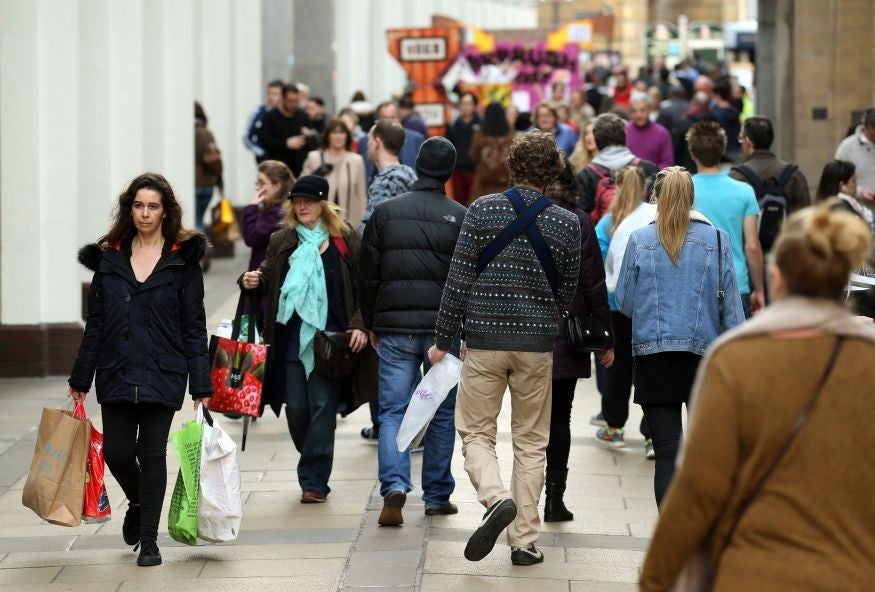If you think Christmas shopping is stressful, try being a retailer
Price reductions have come early and deep this year, as the high street faces multiple challenges

Forget Black Friday, think Super Saturday – or even Panic Saturday. Black Friday, the Friday between the last Thursday in November, Thanksgiving, and the weekend, was always an odd import for British retailers. We don’t celebrate Thanksgiving, for us Christmas ranks as the more important family event. So this last Saturday before Christmas is our biggest shopping day of the year – and actually there are signs that even in the United States it is passing Black Friday in terms of stuff sold. So if you want a snapshot of the wishes, whims and wonders of how Britons spend their money, yesterday was the day to take it.
We do not have numbers yet, but retail sales are running up 4 per cent year-on-year, so in all probability we spent more on Saturday than on any day in our history. But we did not necessarily spend it in the shops, and that is what makes this season so interesting. There are three main socio-economic trends at work. They interlink, but it is more helpful to separate them.
First, there is the obvious shift from shopping in a high street or out-of-town mall to shopping online. Second, there is the shift from buying goods to buying services. And third, there is growth of top-end and bottom-end sales, with the middle squeezed.
On the first, the admittedly sketchy evidence of the past year or so is that out-of-town malls may be more threatened by online than the high street. This is partly because city centres started to fight back, for example by easing onerous parking restrictions, but also because of the other trends noted above, the shift to services and the growth of top-end. Successful city centres can offer a mixed experience in a way most shopping malls can’t, for at their best they mix entertainment (for example, decent restaurants), top-end sales (boutiques, antique shops), and services (hair salons).
The out-of-town fightback is only just getting under way. Yes, they are huge, but they are under pressure. In the US, malls in less-than-favoured locations are shutting down. Here, that is yet to happen, and the malls have time to adapt. But the most interesting example in the UK is that of an outlier, Bicester Village. It is tiny by comparison with regular shopping malls but it is doing a different thing. In Britain it is the prime example of a top-end mall that has global reach: the standard stop on tours for Chinese visitors. Actually, it replicates many functions of the successful high street, with its cluster of top-end brands and feeling of community consumption. The punters could buy most of the stuff on sale by going online but they have come from China for the experience too.
To get a fix on the shift to services, think of the presents you are giving this Christmas. Of course many will be goods. But as the balance of society ages (the median age in Britain last year was 40) people find they prefer to receive services – a nice meal, a theatre ticket, maybe even a weekend abroad, rather than something they could buy themselves by going online for five minutes. A service requires other human beings to provide it on site; it cannot be shipped from a warehouse and left in a box at the door.
There is one further advantage to the shift to services. They will by their nature have to be provided in the weeks ahead rather than in one short retail binge. So consumption is more generally spread, rather than being compressed into Panic Saturday.
Finally, top and bottom end. One of the features of many lines of business is the squeezed middle, but it is particularly evident in retail. There is room at the top, underlined by some troubling figures on wealth from the Office for National Statistics on Friday. These showed that while median household wealth is £225,100, the top 1 per cent have £2,872,600 or more, but the bottom 10 per cent £1,260 or less. And there is room for the discounters, as Aldi and Lidl have shown. But you must have noticed that the sales have not only started early this year, but discounts are unusually deep. This, in a year where retail sales are up 4 per cent, suggests desperation. This Christmas shopping season will be a test and one that may have a disruptive outcome for weaker retailers. If it is a stress test for us to do the shopping, it is a stress test for them to survive.
I think the big point here is that the function of any economy is to create the goods and services people want to buy. Those of course include public services we pay for through taxation, and to produce those goods and services there has to be investment, public and private. But the biggest chunk of the economy by far, some two-thirds, is consumption. The way we spend our money determines what is on offer, for that is the magic of the marketplace. On Saturday we voted with our cash and cards on the shape of the economy we want, even if we did so in a bit of a panic.
Subscribe to Independent Premium to bookmark this article
Want to bookmark your favourite articles and stories to read or reference later? Start your Independent Premium subscription today.

Join our commenting forum
Join thought-provoking conversations, follow other Independent readers and see their replies